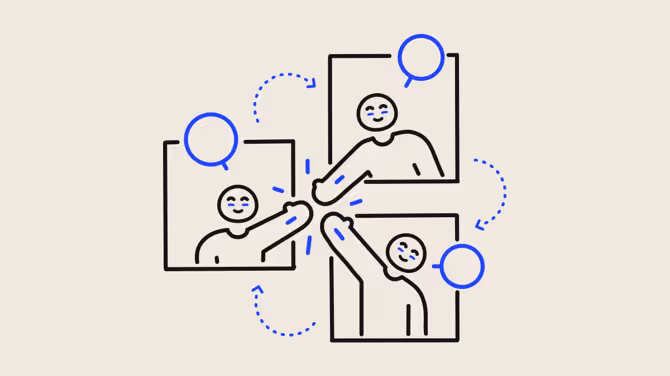Understanding and improving communication in the workplace

Discover Workleap Officevibe's benchmark report on 12 key employee engagement metrics

The words we say aren’t always what people hear.
Tones get misread. Details get lost. Messages land differently depending on who’s receiving them and what kind of mood they woke up in that day.
Clarity is a good thing in any context. But it’s even more important at work. When teams communicate well, they move faster, collaborate better, and get more done.
In this guide, we’ll break down what effective workplace communication looks like, what gets in the way, and how to keep teams aligned as they grow.
Signs of effective workplace communication
Here’s why communication in the workplace is so important:
- Improved engagement: Effective workplace communication increases employee engagement and boosts worker satisfaction. When teams collaborate well and management communicates clearly, everyone has the information they need to work well, which gives engagement a boost.
- Greater motivation: Employees feel more motivated when they understand how their efforts make a difference. Leaders who communicate why everyday tasks are essential to the big picture inspire employees to do their best work.
- Increased morale: When employees know their work matters, morale soars. Good communication helps workers understand the value of their efforts and when they’re performing well. It also creates clear pathways for questions and concerns.
- Improved productivity: Work tends to stall when employees aren’t sure what to do next. But when tasks are effectively conveyed, teams can resolve issues quickly and progress without handholding.
- Reduced churn: A listened-to employee is a more satisfied, engaged employee. Since they’re happier where they are, they’re less likely to leave for other opportunities. Workers are more likely to stay for years, becoming experts in their field and in the operation.
- Better collaboration: People accomplish more when they work together, and solid communication makes effective collaboration possible. Plus, idea-sharing drives creativity, and teams that collaborate innovate faster.
- Fewer workplace conflicts: Conflict is often the result of a misunderstanding. With clear communication, many arguments are completely avoidable. And when they do happen, communicating effectively puts a healthy resolution well within reach.
7 common types of workplace communication
Workplace communication comes in a number of shapes and sizes. Here are six of the most common forms.
1. Leadership communication
Leadership communication refers to the conversations managers have with employees or one another. It might come in the form of one-way messaging, like instructions or organizational updates. Or it could be information-sharing between two managers. And it’s not just leaders talking; leadership communication also includes one-on-one meetings with direct reports.
2. Upward communication
Upward communication is the umbrella term for conversations between people in lower and higher positions in the organization. An employee reporting progress updates to their manager or a manager briefing the CEO are two common examples.
3. Meetings
Meetings bring people together around a clear goal, like planning, problem-solving, or sharing results. One person or team usually leads, but everyone should feel they have space to contribute.
4. Presentations
Presentations are a more formal style of meeting in which one person or team conveys information to a group. These meetings often include accompanying slides to help the crowd better absorb and retain information, and the speaker often comes armed with a script or talking points.
5. Customer communications
Customer communications are conversations between employees and their clients or customers. Depending on the type of business, this might mean personalized or automated email messaging, online chats, phone calls, live presentations, or in-person meetings.
6. Informal communication
Informal communication refers to the spontaneous, unplanned interactions that happen throughout the day. It could be a chat by the water cooler, a quick DM, or a casual check-in. These interactions are brief, spontaneous, and often the place where real connection happens.
7. Asynchronous communication
Asynchronous communications are messages that don’t need to be addressed right away. The classic example is emails, which you send without expecting an immediate response. They can also include non-urgent Slack or Teams posts, or comments left in a Word or Google document.
Typical workplace communication issues
Communicating in work environments isn’t always straightforward. It needs to be clear but kind, direct but respectful. Striking that balance isn’t easy. And when the communication is off, problems start to pile up. Here’s a look at some of the most common issues.
Lack of clarity
When ideas aren’t clear, neither is the work. Whether it’s a rushed email or half-explained verbal instructions, sloppy messaging slows teams down. Taking a moment to offer clarity upfront saves time (and confusion) later.
Interpersonal dynamics
Not everyone in your organization will click, and that’s OK. What matters is keeping communication respectful. Leaders should train their teams to keep personal feelings out of their work conversations. Senior staff should also model clear, respectful messaging as a real-world example of good communication in the workplace.
A lack of listening skills
Active listening takes practice at every level. It means making eye contact, confirming what you’ve heard, and asking questions when things aren’t clear. The more teams listen with intention, the fewer missteps they’ll make.
The iceberg effect
People often assume others share their context. But most of what we know stays below the surface. That’s known as the iceberg effect. Whether you’re giving feedback, sharing updates, or explaining a process, don’t assume everyone’s on the same page. Break it down, giving people what they need to act so they don’t have to guess.
Body language
Nonverbal cues can be just as misleading as spoken words. A yawn might just mean someone’s tired, not that they’re bored. Help teams read the room more clearly by encouraging awareness and reinforcing the need to check in before jumping to conclusions.
Poor feedback
Vague feedback doesn’t help anyone. Leaders should be specific, whether they’re recognizing great work or flagging concerns. Without clarity, employees may walk away confused or go on to overcorrect in the wrong direction.
Fear
Fear shuts down communication fast. Whether it’s avoiding conflict with a peer or worrying about backlash from a manager, people stay silent when they don’t feel safe. But silence creates bottlenecks. Leaders need to create a culture where honest conversations feel not just safe but encouraged.
Silos
Silos form when teams work in isolation, often unintentionally. Information gets stuck inside departments, and cross-functional collaboration breaks down. Without clear channels between teams, priorities get misaligned, context gets lost, and work slows down. The bigger the organization, the more intentional you need to be about keeping teams connected.
Too many messages
More tools don’t always mean better engagement or communication. Between emails, DMs, and video calls, employees can spend more time catching up than getting work done. Encourage intentional use of messaging tools so the result is clarity instead of noise.
The best tools for workplace communication
Strong communication starts with habits. And the right tools help healthy communication skills within the workplace scale. Here are some of the best platforms for improving communication:
- Workleap Officevibe: Officevibe keeps feedback flowing. HR teams use this powerful engagement engine to gather insights through weekly surveys that help them spot engagement trends early. It also fosters recognition: Managers and peers can shout out great work in the moment, helping teams feel seen and supported.
- Slack: Slack makes it easy to share updates, files, and ideas across teams, both asynchronously and in real time. It’s great for cross-functional collaboration and company-wide announcements, with channels that keep conversations organized.
- Google Workspace: Google Workspace is a software suite that helps teams stay connected. Gmail offers email and messaging capabilities, Meet hosts video conferences, Drive stores files in the cloud, and Calendar allows team members to easily track their schedule and send out meeting invites.
- Connecteam: Connecteam is a collaboration and messaging app built for mobile-first workplaces. It keeps remote and hybrid teams engaged through messaging, scheduling, and task management, making employee engagement a priority no matter where your team is located.
Level up your workplace communication with Workleap
Improving communication in the workplace starts with better visibility. And thanks to Workleap Officevibe, that’s never been easier.
Officevibe gives HR teams a real-time read on how people communicate and where things break down. With always-on surveys, anonymous feedback, and built-in recognition, you’ll spot issues early, strengthen team dynamics, and help managers lead with clarity.
Get started for free to see how Workleap helps teams work better together.
Give HR and managers the clarity, confidence, and connection to lead better every day.


%20(1).avif)


.avif)
.avif)







